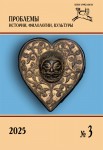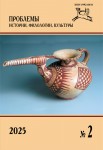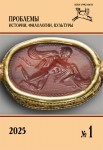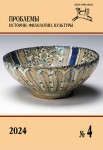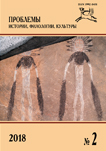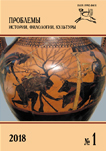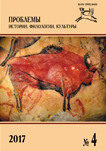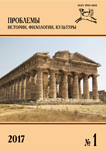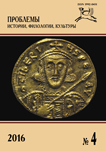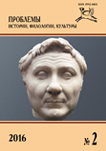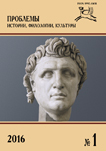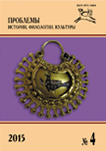Аннотация
Тюхе – божество судьбы, удачи, чей культ был популярен в эллинистический и римский периоды. Существовали ее ипостаси, олицетворявшие «счастье» правителя. Статья посвящена персонификации «счастья» царя Селевка II, упомянутой в клятве магнесийских катойков (OGIS 229. II). В статье были проанализированы имеющиеся свидетельства существования царской Тюхе в эллинистическом мире для уточнения образа божества в идеологии династии Селевкидов. Автор предполагает, что роль царского «счастья» в идеологии этой династии была в целом незначительной. Сделан вывод о том, что в «счастье царя Селевка» стоит видеть не «личного гения», а божество, имеющее тесную связь с правителем. Появление селевкидской Тюхе можно рассматривать как развитие ритуала клятвы в эллинистический период и проявление интереса к богине не только со стороны монархии, но и со стороны ее подданных.
Ключевые слова
Тюхе, Селевк II, клятва, катойки, Селевкиды.
Бикерман, Э. 1985: Государство Селевкидов. М.
Виноградов, Ю.Г., Шестаков, С.А. 2005: Laudatio funebris из Пантикапея. ВДИ 2, 42–44.
Габелко, О.Л. 2005: История Вифинского царства. СПб.
Зайцев, Ю.П., Мордвинцева, В.И. 2007: Датировка погребения в Ногайчинском кургане. Диалоги с оппонентом. В сб.: Ю.П. Зайцев, В.И. Мордвинцева (ред.), Древняя Таврика. Сборник в честь 80-летия Т.Н. Высотской. Симферополь, 319–358.
Обухов, С.В. 2018: Пантеон и царский культ в Коммагене в эпоху Митридата I Каллиника и Антиоха I Теоса. Дис.… канд. ист. наук. М.
Сапрыкин, С.Ю. 2017: Иранские традиции в политике, идеологии и культуре Понтийского царства. Scripta antiqua. Вопросы древней истории, филологии, искусства и материальной культуры. Т. 6. М., 280–310.
Сапрыкин, С.Ю. 2009: Религия и культы Понта эллинистического и римского времени. М.–Тула.
Сапрыкин, С.Ю. 2005: Энкомий из Пантикапея и положение Боспорского царства в конце I–начале II в. н.э. ВДИ 2, 45–81.
Тохтасьев, С.Р. 2015: Надписи на перстнях, содержащие слова ХАРА и ΨΥΧΗ. В сб. М.Ю. Трейстер (ред.), Золото Фанагории (В.Д. Кузнецов (ред.), Фанагория. Результаты археологических исследований. Т. 2). М., 201–206.
Ханиотис, А. 2013: Война в эллинистическом мире: Социальная и культурная история. СПб.
Харченко, А.А. 2010: Асандр и Хрисалиск (опыт гипотетической персональной истории). В сб.: Л.П. Репина (ред.), В тени великих: образы и судьбы. Сборник научных статей. СПб., 178–190.
Шенкарь, М. А. 2013: Об иконографии xvarǝnah и его роли в идеологии древних иранцев. В сб.: Последний энциклопедист: К юбилею Б.А. Литвинского. М., 427–451.
Aumond, L. 2004: Le Traité de Sympolitie entre Smyrne et Magnésie-du-Sipyle (242/1 av. J.C.) et le concept de patrios kora à l’époque hellénistique. Université Laval.
Bar-Kochva, B. 1976: The Seleucid Army: Organization and Tactics in the Great Campaigns. Cambridge.
Bayliss, A.J. 2013: Oaths of offi ce. In S. Daub, M. Erler, D. Gall, L. Koenen, C. Zintzen (eds.), Oath and State in Ancient Greece. Beiträge zur Altertumskunde. Vol. 306, Berlin–Boston, 33–46.
Baynham, E. 1998: Alexander the Great: The Unique History of Quintus Curtius. University of Michigan Press.
Beare, R. 1980: Ptolemy’s Daimon and Ruler-Cult. Klio 62, 327–330.
Berti, I. 2006: “Now let Earth be my witness and the broad heaven above, and the down fl owing water of the Styx…” (Homer, Mas XV, 36–37): Greek oath-rituals. In E. Stavrianopoulou (ed.), Ritual and Communication in the Graeco-Roman World. Liege, 181–209.
Boyce, M., Grenet, F. 1991: A History of Zoroastrianism, Zoroastrianism under Macedonian and Roman Rule. Leiden–New York–København–Köln.
Bricault, L., Caneva, S.G. 2019: Sarapis, Isis et la continuité dynastique lagide. À propos de deux dédicaces ptolémaïques d’ Halicarnasse et de Kaunos. Chiron 49, 1–22.
Chaniotis, A. 2002: Foreign Soldiers – Native girls? Constructing and Crossing Boundaries in Hellenistic Cities with Foreign Garrisons. In A. Chaniotis, P. Ducrey (eds.), Army and Power in the Ancient World. Stuttgart, 99–113.
Clayman, D.L. 2014: Berenice II and the Golden Age of Ptolemaic Egypt. New York.
Dittenberger, W. (ed.) 1903: Orientis Graeci Inscriptiones Selectae. Supplementum Sylloges inscriptionum graecarum. Vol. I. Lipsiae.
Dmitriev, D. 2011: The Greek Slogan of Freedom and Early Roman Politics in Greece. New York.
Elwyn, S. 1990: The Recognition Decrees for the Delphian Soteria and the Date of Smyrna’s Inviolability. JHS 110, 177–180.
Feldmann, W. (ed.) 1885: Analecta Epigraphica Ad Historiam Synoecismorum Et Sympolitiarum Graecorum. Argentorati.
Fingerson, K.R. 2007: Persian Katoikoi in Hellenistic Smyrna. Ancient Society 37, 107–120.
Fingerson, K.R. 1998: Smyrna 573: A Study in Hellenistic Civic Organization During the Third Syrian War (246-241 B.C.). University of Wisconsin–Madison.
Gardner, P. 1888: Countries and Cities in Ancient Art. JHS 9, 47–81.
Grainger, J. 2010: The Syrian Wars. Leiden–Boston.
Grenfell, B.P., Hunt, A. S. 1901: Ptolemaic Papyri in the Grizeh-Museum. Archiv für Papyrusforschung und verwandte Gebiete I, 57–65.
Haussoullier, В. 1880: Inscriptions d’Halicarnasse. Bulletin de correspondance hellénique 4, 395–408.
Houghton A., Lorber, C. 2002. Сatalogue, https://catalogue.bnf.fr/ark:/12148/cb41858594h. public
Ihnken, T. 1978: Die Inschriften von Magnesia am Sipylos: mit e. Kommentar zum Sympolitievertrag mit Smyrna. Bonn.
Kılıç, M. 2014: The cults of Nemeseis and Tyche at Smyrna. Belleten 283, 833–854.
Liddell, H.G., Scott, R., Jones, H.S., McKenzie, R. (eds.) 1996: A Greek-English Lexicon. Vol. II. Oxford.
Matheson, S.B. 1994: The Goddess Tyche. In S.B. Matheson (ed.), Yale University Art Gallery Bulletin. An Obsession with Fortune: Tyche in Greek and Roman Art. Yale University, 18–33.
Moore, W. 1986: The divine couple of Demetrius II, Nicator, and his coinage at Nisibis. ANSMN 31, 125–143.
Nilsson, M. P. 1943: Problems of the History of Greek Religion in the Hellenistic and Roman Age. Harvard Theological Review 36(4), 251–275.
Olshausen, E. 1990: Götter, Heroen und ihre Kulte in Pontos. ANRW 18/3, 1865–1906.
van Oppen, B.F. 2015: Berenice II Euergetis: Essays in Early Hellenistic Queenship. New York.
Pfeiffer, S. 2008: The god Serapis, his cult and the beginnings of the ruler cult in Ptolemaic Egypt. In P. McKechnie, P. Guillaume (eds.), Ptolemy II Philadelphus and his world. Leiden– Boston, 387–408.
Pfeiffer, S. 2008: Herrscher- und Dynastiekulte im Ptolemäerreich: Systematik und Einordnung der Kultformen. München.
Sherwin-White, S., Kuhrt, A. 1993: From Samarkhand to Sardis: A New Approach to the Seleucid Empire (Hellenistic Culture and Society). Berkeley–Los Angeles.
Smith, A.C. 1994: Queens and Empresses as Goddesses: The Public Role of the Personal Tyche in the Graeco-Roman World. In S.B. Matheson (ed.), Yale University Art Gallery Bulletin. An Obsession with Fortune: Tyche in Greek and Roman Art. Yale University, 86–105.
Spyridakis, S. 1969: The Itanian Cult of Tyche Protogeneia. Historia: Zeitschrift für Alte Geschichte 18.1, 42–48.
Tuplin, C. 2014: The military dimension of Hellenistic kingship. An Achaemenid inheritance? In F. Hoffman, K.S. Schmidt (eds.), Orient und Okzident: Antagonismus oder Konstrukt? Machtstrukturen, Ideologien und Kulturtransfer in hellenistischer Zeit. Vaterstetten, 245– 276.
Wallace, J. 2011: Legal Theories and Ancient Practices in John Selden’s Marmora Arundelliana. Journal of the History of Ideas 3. Vol. 72, 393–412.
Williamson, C. 2013: As God is my witness. Civic oaths in ritual space as a means towards rational cooperation in the Hellenistic polis’. In R. Alston; Onno M van Nijf; C.G. Williamson (eds.), Cults, Creeds and Identities in the Greek City after the Classical Age. Vol. 3. Leuven– Paris–Walpole MA., 119–174.




